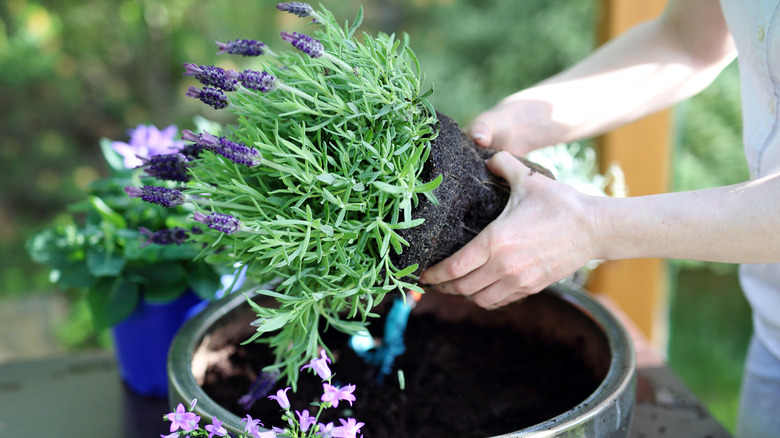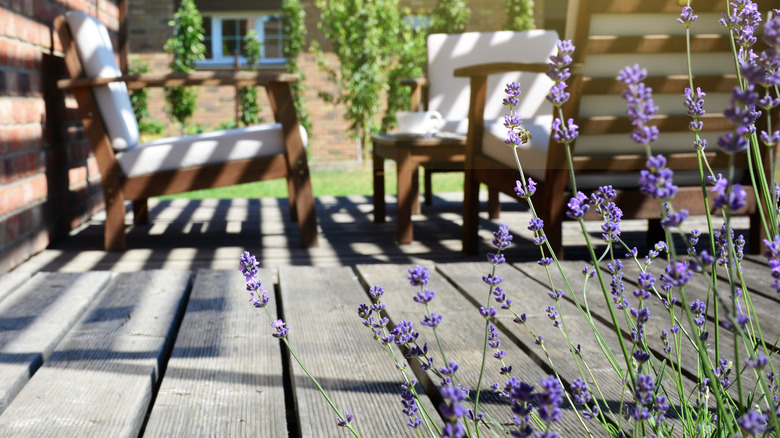TikTok's Natural Answer To Mosquito Pest Control Is An Easy DIY Planter
Ah, the first signs of summer. Rainstorms are settling down, backyard pools are heating up, gardens are entering peak production, and ... what's that sound? A tiny helicopter? A mouse whistling over your shoulder? Nope; it's a cloud of mosquitoes honing in on your ankles, poised and ready to make you itch all night. Living in an area plagued by mosquitoes can make it difficult to enjoy time outdoors without dousing yourself in stinky repellents. If you feel like you're an unlucky "mosquito magnet" who smells especially attractive to mosquitoes, research funded by the National Institutes of Health has shown that you may be right! Levels of carboxylic acids in your skin play a key role in how many mosquito bites you'll likely acquire outdoors. Luckily, a TikTok tutorial shared by Armstrong Garden Centers (@armstronggarden) shows a simple planting setup you can use to repel mosquitoes from your yard and keep them from attacking you and your summer barbeque guests. Plus, it's completely natural and pesticide-free. All you'll need is the right combination of mosquito-repelling plants that actually work to send those little bloodsuckers buzzing for the hills.
Unlike some other mosquito-repelling solutions, this planter features delightfully fragranced and even edible plants, perfect for decorating your patio while simultaneously providing protection from mosquitoes. Here's what you'll need to build your own planter and the best way to make use of these tender plants that are tough on mosquitoes.
Building your own anti-mosquito planter
The tutorial shared by Armstrong Garden Centers is super simple to follow and uses widely available materials you can find at your local garden center. First, grab a large, well-draining planter pot with enough space for multiple plants and a cactus blend soil mix. "The variation in particle sizes allows for larger pore space and better drainage," says Armstrong Garden Center. Once you've got your soil in place, it's time to fill it with anti-mosquito plants, starting with a healthy clump of lavender.
English lavender is an excellent choice, but there are many varieties, so choose one that suits your climate. According to a study published in the Journal for the Society of Vector Ecology, linalool, a compound in lavender, repels up to 93% of mosquitoes when placed in a diffuser, giving the plant itself some similar properties. Next, pop some marigolds into the planter. Pyrethrum and thiophenes contained in marigolds repel or even kill many pests, including mosquitoes and mosquito larvae. Catnip is the next factor in this mosquito-defense planter. A member of the mint family, catnip contains nepetalactone, which has been shown to be 10 times more effective than DEET. Spearmint is the final plant in this anti-mosquito mix, and should be given its own pot to prevent it from taking over. "Menthol, the active insect-fighting ingredient in mint and peppermint oil, has biocidal properties that help repel and control mites, mosquitoes, and various other pests," Armstrong Garden Centers wrote in its TikTok caption.
Choose an optimal location for your planter
For the best results, place your mosquito-repelling planter near patios and seating areas, where you want humans to be able to enjoy the outdoors sans mosquito bites. Use multiple planters as needed and make sure the pots are within comfortable reach. If you notice that the mosquitoes are particularly aggressive at any given time, the lavender and catnip can also be plucked from the planter and applied to your body. "It smells good to humans but mosquitoes hate it," Armstrong Garden Center explained in its tutorial. "In order to activate the mosquito-repelling properties of these plants, you have to take a leaf, tear them up, and vigorously rub the oils onto your skin." Each application should provide about 30 minutes of natural mosquito protection. Just watch out for bees on your lavender and marigolds! While they may repel mosquitoes, these plants are still very honeybee-friendly.
You can also grow these plants together near raised gardens, bird baths, pools, ponds, and other areas where mosquitoes tend to hide out. Marigolds, spearmint, catnip, and lavender all have similar care requirements, making them great companion plants that you should grow together. Aim for somewhere with full sun to partial shade, and water the plants only when their soil begins to dry, roughly one to two times per week.

